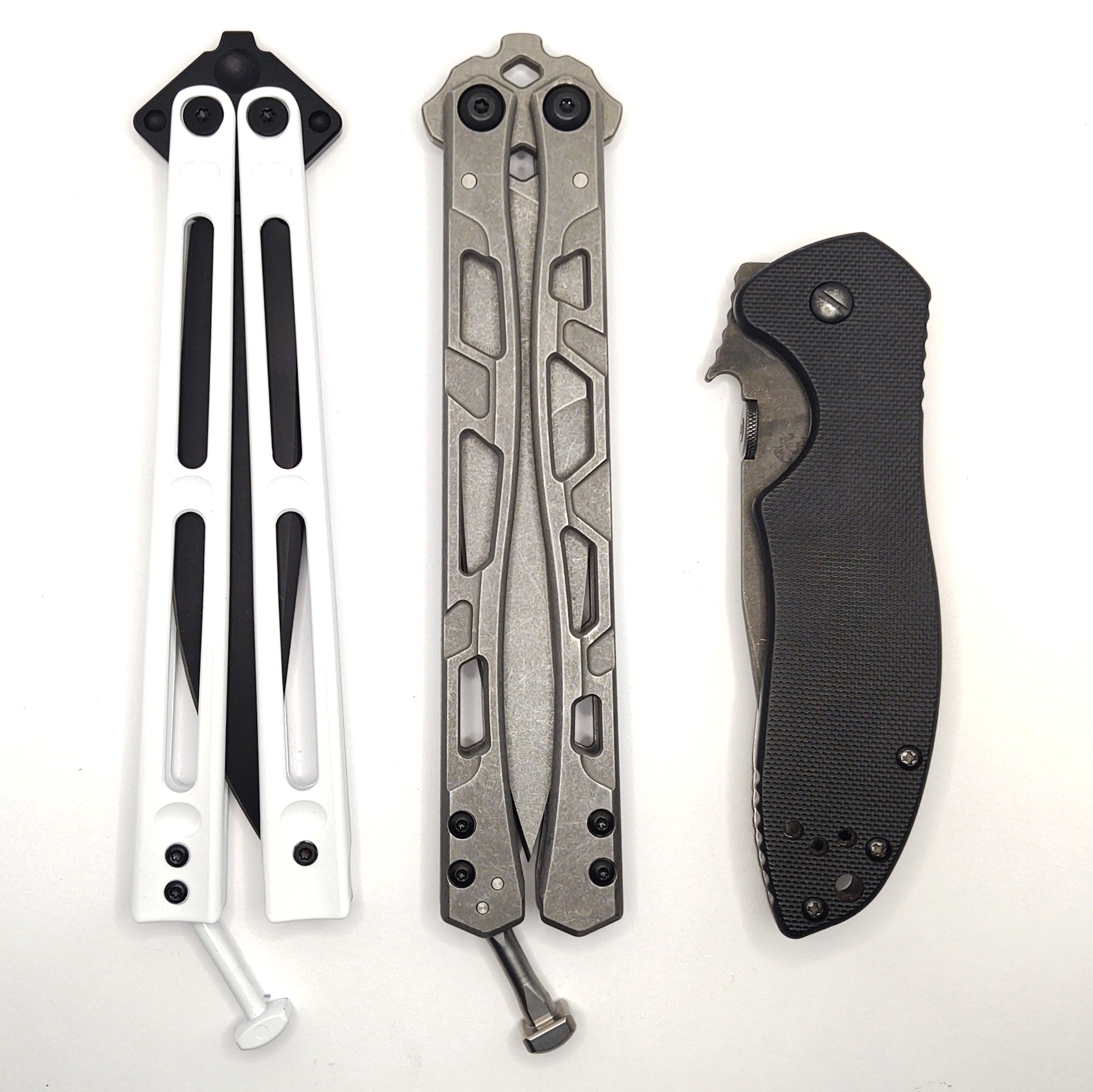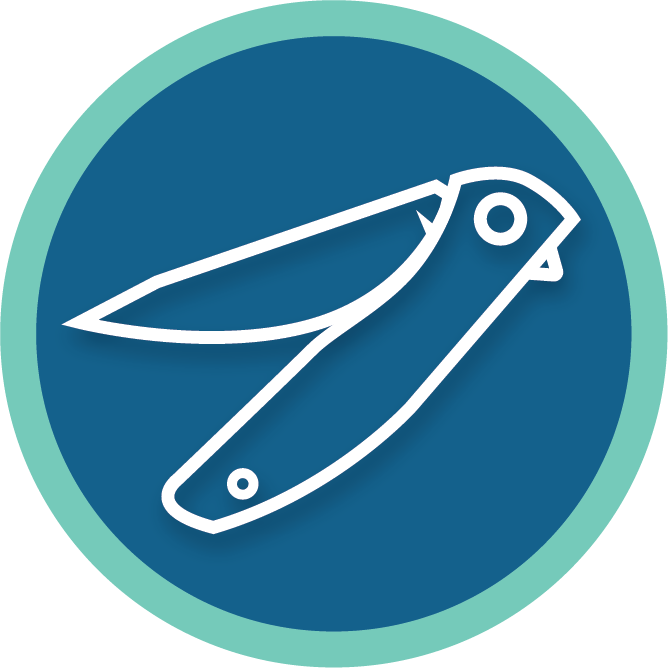Just the other day I posted a picture of my entire selection of balisongs, and I’m reporting to you now with great satisfaction that this picture is already out of date.

This is the Böker “Papillon,” model 06EX116SOI. Just like the last Böker I sung the praises for a few days ago, this knife is in the process of discontinuation and is thus heavily marked down. I paid $40 for this, same as the 06EX227. But I notice right now at the time of writing BladeHQ actually has these slashed to $30. Link here, no affiliation as usual.
“Papillon” means butterfly in French. Indeed, that’s what this knife is. (It’s also a breed of dog. That’s neither here nor there.) If you think that’s gratuitous, look, it’s better than if they named it in German. Then we’d have wound up with the “Schmetterling.”
You can get this knife in a few colors… Black. Grey. Bor-ing. Instead, I just had to go with this Imperial Stormtooper aesthetic white model for something different. It’s really quite striking.

The handles are gloss painted, and they are very, very white. This actually presented a bit of a photography problem for me because as you know, my trademark is knives floating in an infinite white void. Knives usually aren’t white so this isn’t normally a problem. I just overexpose the pants off of the shot so the background ends up pure stark white and I can bring out the contrast on whatever dark colored knife we’re messing with, maybe paint over any stray specs of dirt or grease left on the background, and away we go.
Well, I can’t do that here. If I do, the handles become invisible. Oh, sure, I could go find some black felt or something and shoot on a black background. But then the blade would disappear. I can’t win.

Plan C is to fastidiously doctor every single photograph, hand-preserving the shadows, highlights, and edges. That’s what I did in this shot, for instance, but my patience for this sort of thing is finite.
So some of these photos are going to show hints of a little more background than usual. You’ll just have to put up with it.
Right. The Papillon. Is it any good?

Eh. I like it a lot less than the little 006EX227 Böker. This knife is a fair deal at $30 or $40 but if you ask me the quality is not in line with its original $90 asking price.
There, that’s really the whole thing dealt with. I failed to hang on to the suspense until the end; if that was the only question you needed answered you can click away now and none of the rest of this treatise actually matters.
The Papillon is a full traditional or “competition size” knife at 10-1/16" long when open, 5-7/8" closed. The clip point blade is 4-5/8" long measured from the forward ends of the handles with about 4-1/8" of usable edge. It’s powdercoated or painted or whatever in a matte black finish, made of D2 steel, and 0.147" thick. The blade has a full flat grind on it which is a little unusual, and a pronounced choil at the base of the edge because this is, as is becoming popular these days, a kicker-pin-less “Zen” pin design and the rebound pin on the bite handle slots into the choil (and the other one goes into a matching cut opposite it on the spine of the knife).
There is no clip provided. That’s probably just as well; the Papillon is really just too humongous for practical daily carry.
The dimensions and construction methodology of this knife put me in mind of the Kershaw Moonsault and its related brethren, the Lucha and Balanza. Actually, there even is a “Stormtrooper White” variant of the Lucha already. This knife and those have very similar feature sets.

The Papillon, however, has a much more traditional shape with a tapered profile flaring wider towards the latch end. The handles are unitary slabs of steel, flat on the insides and milled with weight reducing slots and are concave on the outside. It’s lighter than the Moonsault: 123.5 grams or 4.36 ounces.

The latch is a fairly traditional T shape and is not spring loaded. My example is also far too tight due to the handles hitting their endstops too far apart from each other, ultimately requiring a heroic squeeze to get the knife either latched or unlatched. The singular review of this knife on BladeHQ mentions the same thing. I also figured out why this is, which I’ll get to.

Because of this it’s already rubbed through the paint where the latch head rides over the tips of the handles.

The latch does at least have two endstop pins that prevent it from rotating more than 180 degrees. The blade is thusly protected from being struck and potentially damaged by the latch. So that’s nice.
The pivot action and handle feel are also nice, although a distinct lack of refinement is evident as revealed by the wiggle test:

Which is weird.

Because the Papillon totally does have ball bearing pivots.

Normally this is an easy path to rock solid handle feel with no play, but that’s not the case here. And once again, nothing in the product description or specs anywhere mention the presence of the bearings. I sense a recurring theme, here, and I really can’t fathom why this is.
The pivot screws themselves are plain round Chicago screws with no indexing or D flats or any other niceties. So yes, if you try to unscrew the wrong side the entire thing will just spin, accomplishing nothing. The pivot holes in the handles on mine appear to be a little wonky, and I can’t tell if that’s down to the machine work or just buildup of the paint. I suspect there’s a not insignificant amount of gap between the pivot screws and the handle holes by design – if the handles are painted after the final machining, which it seems that they are, the tolerances there by necessity would have to be pretty wide to guarantee that the holes don’t get so gunked up with paint that you couldn’t get the hardware through.
Here’s the whole thing in bits:

The knife is held together with the pivot screws and just one spacer in each handle, down towards the end, with a pair of screws in each side. There’s quite a bit of flex in the handles themselves. And on the safe handle, with only two points of contact, the handle halves aren’t kept square with anything relative to one another. The rebound pins, latch stop pins, and latch pivot pins are just slices of round stock and are not precision machined, nor are their tips particularly square, nor are they shouldered or indexed in any way.
The handle slabs aren’t precision machined, either. For instance, due to a slight inaccuracy in the pocket drilled for it, one of my rebound pins always rests sightly crooked, as pictured below.

The hole it homes into is visibly slightly mis-drilled:

And it’s no good swapping the handle parts around to try to luck into a better fit because the bite handle and safe handle halves are not the same, with the bite handle having one more pair of screw holes.
I did ultimately cure this by precision remachining hogging out the offending pin hole with a Dremel and a tiny carbide end mill bit. It worked; the latch is now noticeably easier to undo albeit still not perfect. I could go as far as grinding an offset into the pin but, do you know, I can’t be bothered. If ever there were a candidate for de-latching a knife, it would be this one.
Note also that there is no cutout for the bearings to rest in on the insides of the handles. The blade is pocketed, but the handle slabs aren’t. So the balls will just chew a groove into the paint like you see here.
On the previous Böker balisongs I reviewed I commented on the precise fit of the parts and ease of reassembly brought about thereby. Well, that’s not the case here. Getting the Papillon’s handle halves fully back together took some wiggling and fiddling around every time I did it.

Here’s how the latch endstops work. This is simple, effective, inexpensive, and there’s really no excuse for every balisong manufacturer not to do something like this.

One other foible I noticed is how close to the outside of the handles the edge rests when the knife is closed. This is thanks to the pronounced belly in the shape of the blade. I stuck the tail of my calipers down there and this reveals that the edge is only 0.054" away from the outside surface of the handle on that side. It is definitely possible to mash the tips of your fingers into the gap between the handles hard enough to touch the edge. So maybe don’t do that.

Aesthetically, I really do like the Papillon. The black-on-white colorway is certainly fresh and, dare I say, attractive. Since it doesn’t need kicker pins pressed through the blade, it instead has these hemispherical cutouts which are pretty cool. And it’s got an actual name this time rather than just a meaningless robotic alphanumeric string. It’s even fun to say: Papillon, Papillon.

Like apparently all Böker balisongs, the Papillon comes in one of their little fleece lined zipper cases.
This case is identical to the ones I’ve gotten before, including the one that came with the 06EX227 (which I did not mention due to rattling on so long in that writeup already).

It has various pockets in it, although as usual I can’t explain why since they’re all so flat there’s no way you’d be able to cram more than one knife in this thing. It comes with the customary two pamphlets from Böker, one in English and one in German. I didn’t post them because we’ve seen them before. They appear to be identical for all current Böker knives.

For your comparison, the Papillon (left), Kershaw Moonsault (center), and a CQC-6K (right). The Papillon and Moonsault really are nearly identical in length and for the most part width, notwithstanding the taper on the Papillon. The Moonsault is better built, dang it, but it also costs a lot more than $30.
If you ask me, the Papillon’s feel in the hand is actually better, though. It doesn’t have the clangy resonance issues of the Moonsault, and I like the smooth finish better, paradoxically, despite it having the potential to be more slippery. The Papillon is pretty quiet as you flip it. Even the latch doesn’t make too much noise. So flawed though it may be, it actually has it where it counts.
The Inevitable Conclusion
The Papillon turns out to be a middling knife. An in-betweener: A cut above flea market made-in-China garbage knives, but several pegs below the premium balisongs not only made by other brands, but by Böker themselves.
Maybe that’s why it’s presently standing poised to get the chop.
If you look at it from the perspective of being a poor man’s Kershaw Lucha, though, it starts to become a little more appealing. At $30 it’s a reasonably good bargain, and probably the cheapest way at the moment to get your hands on a ball bearing balisong. (Say that ten times, fast.) At the full original list price, though? Not so much.
I don’t actually care that much about knives, except for their use in the kitchen, but I always read your reviews.
I really appreciate you attention to detail, and your photos.
Thank you for posting these. Also, I’m a motorcycle in general, and dual sport in particular dork. Ride safe.


